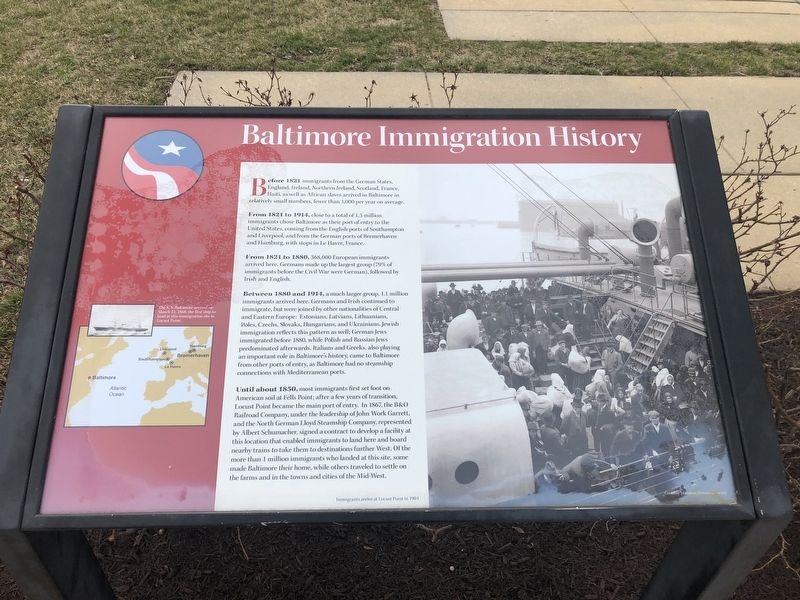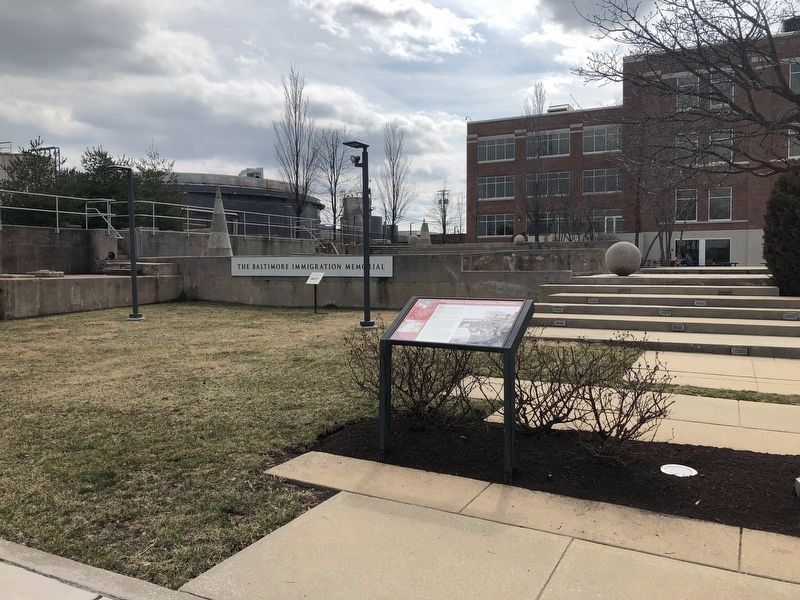Locust Point Industrial Area in Baltimore, Maryland — The American Northeast (Mid-Atlantic)
Baltimore Immigration History
From 1821 to 1914, close to a total of 1.5 million immigrants chose Baltimore as their port of entry to the United States, coming from the English ports of Southampton and Liverpool, and from the German ports of Bremerhaven and Hamburg, with stops in Le Havre, France.
From 1821 to 1880, 368,000 European immigrants arrived here. Germans made up the largest group (79% of immigrants before the Civil War were German), followed by Irish and English.
Between 1880 and 1914, a much larger group, 1.1 million immigrants arrived here. Germans and Irish continued to immigrate, but were joined by other nationalities of Central and Eastern Europe: Estonians, Latvians, Lithuanians, Poles, Czechs, Slovaks, Hungarians, and Ukrainians. Jewish immigration reflects this pattern as well; German Jews immigrated before 1880, while Polish and Russian Jews predominated afterwards. Italians and Greeks, also playing an important role in Baltimore's history, came to Baltimore from other ports of entry, as Baltimore had no steamship connections with Mediterranean ports.
Until about 1850, most immigrants first set foot on American soil at Fells Point; afer a few years of transition, Locust Point became the main port of entry. In 1867, the B&O Railroad Company, under the leadership of John Work Garrett, and the North German Lloyd Steamship Company, represented by Albert Schumacher, signed a contract to develop a facility at this location that enabled immigrants to land here and board nearby trains to take them to destinations further West. Of the more than 1 million immigrants who landed at this site, some made Baltimore their home, while others traveled to settle on the farms and in the towns and cities of the Mid-West.
[Captions:]
The S. S. Baltimore arrived on March 23, 1868, the first ship to land at this immigration site in Locust Point.
Immigrants arrive at Locust Point in 1904
Topics. This historical marker is listed in these topic lists: Churches & Religion • Settlements & Settlers • Waterways & Vessels. A significant historical date for this entry is March 23, 1868.
Location. 39° 16.528′ N, 76° 35.43′ W. Marker is in Baltimore, Maryland. It is in the Locust Point Industrial Area. Marker is on North Haubert Street north of Key Highway East, on the right when traveling north. Marker is on the grounds of the Baltimore Immigration Memorial. Touch for map
Other nearby markers. At least 8 other markers are within walking distance of this marker. Locust Point Immigration Depot (a few steps from this marker); Merchant Ship Cannon (approx. 0.4 miles away); Welcome to the Frederick Douglass - Isaac Myers Maritime Park & Museum (approx. 0.4 miles away); Lady Maryland (approx. 0.4 miles away); The Black Shipbuilders of the Chesapeake Bay (approx. 0.4 miles away); Sigsbee (approx. 0.4 miles away); 931 Fell Street (approx. 0.4 miles away); Frederick Douglass Sculpture (approx. 0.4 miles away). Touch for a list and map of all markers in Baltimore.
Credits. This page was last revised on July 31, 2022. It was originally submitted on March 16, 2019, by Devry Becker Jones of Washington, District of Columbia. This page has been viewed 1,176 times since then and 238 times this year. Photos: 1, 2. submitted on March 16, 2019, by Devry Becker Jones of Washington, District of Columbia.

